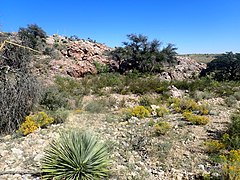| Fusselman Formation | |
|---|---|
| Stratigraphic range: early Silurian PreꞒ Ꞓ O S D C P T J K Pg N | |
 Fusselman Formation at Quartzite Ridge, Lake Valley, New Mexico, USA Fusselman Formation at Quartzite Ridge, Lake Valley, New Mexico, USA | |
| Type | Formation |
| Sub-units | Chamberino Member, Flag Hill Member, Crazycat Member |
| Underlies | Percha Formation |
| Overlies | Montoya Group |
| Thickness | 1,400 meters (4,600 ft) |
| Lithology | |
| Primary | Dolomite |
| Location | |
| Coordinates | 31°53′14″N 106°28′40″W / 31.8873°N 106.4779°W / 31.8873; -106.4779 |
| Region | Texas |
| Country | United States |
| Type section | |
| Named by | G.B. Richardson |
| Year defined | 1908 |
  | |
The Fusselman Formation is a geologic formation in westernmost Texas and southern New Mexico. It preserves fossils dating back to the early Silurian period.
Description

The formation consists mostly of medium to dark gray massive dolomite. It has a light and dark banded appearance due to alternating beds of light gray peritidal laminated carbonate mudstone and dark gray cherty wackestone or packstone containing abundant corals. The total thickness is over 1,400 meters (4,600 ft) in the Florida Mountains but the formation varies greatly in thickness. The formations unconformably overlies the Montoya Group and is overlain by the Onate Formation. The upper contact shows that the area was tilted and eroded prior to the Devonian.
The formation is divided into the Chamberino, Flag Hill, and Crazycat members in the Sacramento Mountains.
Extensive dolomitization of the formation has obscured its primary depositional fabric and made interpretation of its depositional environment difficult.
Fossils
The formation is relatively poor in fossils compared with the underlying El Paso Formation. However, it contains fossils of pentamerid brachiopods, corals, and stromatoporoids. These include the corals Cyanthophyllum, Favosites, Halysites, and Heliolites and the gastropod Hormatoma.
Economic geology
The uppermost part of the formation shows significant barite-fluorite and base metal mineralization, where migrating fluids are trapped by the overlying impermeable shale formations.
History of investigation
The name was first used by G.B. Richardson in 1908 for outcrops in Fusselman Canyon in the Franklin Mountains. It was divided into members in the Florida Mountains by Kottlowski and Pray in 1967.
See also
Footnotes
- ^ Richardson 1908.
- Pope 2004.
- ^ Pope 2004, p. 56.
- Poole et al. 1992.
- ^ Kottlowski & Pray 1967.
References
- Kottlowski, Frank E.; Pray, Lloyd C. (1967). "Silurian Outcrops of Southcentral and Southwestern New Mexico". Tulsa Geological Society Digest. 35: 209–230. Retrieved September 15, 2020.
- Poole, F.G.; Stewart, J.H.; Palmer, A.R.; Sandberg, C.A.; Madrid, R.J.; Ross, R.J. Jr.; Hintze, L.F.; Miller, M.M.; Wrucke, C.T. (1992). "Latest Precambrian to latest Devonian time; development of a continental margin". In Burchfiel, B.C.; Lipman, P.W.; Zoback, M.L. (eds.). The Decade of North American Geology (DNAG). Vol. G-3. Geological Society of America, The Geology of North America. pp. 9–56.
- Pope, Michael C. (2004). "Upper Ordovician and lower to middle Silurian miogeoclinal rocks". In Mack, G.H.; Giles, K.A. (eds.). The geology of New Mexico. A geologic history: New Mexico Geological Society Special Volume 11. pp. 45–58. ISBN 9781585460106.
- Richardson, G.B. (1908). "Paleozoic formations in Trans-Pecos Texas". American Journal of Science. 4th Series. 25 (49): 474–484. doi:10.2475/ajs.s4-25.150.474.